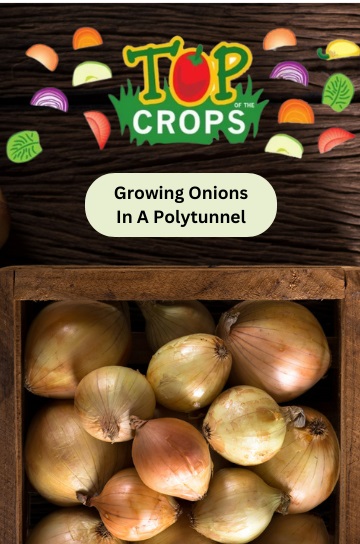Welcome to Top of the Crops! Today, you will learn everything that there is to know about growing onions in a polytunnel.
Onions are relatively easy to grow at home and doing so can give you a versatile ingredient for use in a wide range of dishes. Onions can also be very useful while they are in active growth in your garden, and with their pungent smell, often confuse, distract or repel pest species and so are useful companion plants for a number of other crops.
When we talk about growing onions in a garden, we are most often talking about Allium cepa, biennial or sometimes perennial plants most often grown as an annual crop. These common onions are only known in cultivation and their original wild ancestor is unknown.
We'll be talking about common annual onions in this guide. But it is also worth thinking about growing some other members of the same genus – other, sometimes perennial onions and relatives like shallots, leeks etc.. are also well worthwhile growing in your garden.
Common onions are usually planted out as young immature bulbs, or sets in the autumn (undercover or with protection) or in the spring and are harvested between July and September. Alternatively, they can also be sown indoors in late winter or early spring. The harvest period will be roughly the same with either option but sets will be mature and ready to harvest a little sooner.
| Jan | Feb | Mar | Apr | May | Jun | Jul | Aug | Sep | Oct | Nov | Dec | |
| Sow |  |
 |
 |
|||||||||
| Plant |  |
 |
 |
 |
||||||||
| Harvest |  |
 |
 |
 |
Onions will grow best in a site with full sun, that is relatively mild and sheltered.
They need a moist yet free draining or free draining soil or growing medium that is fertile and relatively rich in organic matter. They need an alkaline or neutral soil and will not do well in acidic conditions. Where the pH is below 6.5 liming may be required before onions will grow successfully.
Onions can be grown in a wide range of different spots in a garden. You might grow them in a typical raised bed or vegetable plot, or you might choose to grow some in containers.
Onions make good companion plants for a range of crops. In particular, they are often considered to be good companions for carrots. Carrots and onions each repel, confuse or distract pests that plague the other with their strong aromas.
However, avoid growing onions near peas or beans as onions may stunt the growth of these legumes when grown close by.
To grow onions in your garden you will require:
onion seeds or onion sets of the variety or varieties that you have chosen to grow.
Seed trays, pots or other containers for seed sowing if starting from seed indoors.
Suitable seed-starting potting mix if starting seeds indoors.
Of course, you will also need a suitable location to grow your onions, taking into account the growing conditions that onions require, other plants nearby, and your overall plans for your garden.
Onions are especially easy to grow from sets, though even growing them from seed is not usually a hugely challenging process.
You can also regrow an onion from scraps, by replanting a section of an onion bulb with roots on it. However, note that this is not really recommended as it can spread disease and the onion might not be of a suitable variety for where you live.
Onion sets are usually planted in March or April, though some varieties, suitable for overwintering, can also be planted in the autumn months, in September or October.
Make sure that the planting area is free from weeds, and that it has been amended with organic matter, then plant the seeds along furrows or individually, making sure that each one is around 2cm deep so that the pointed tip of each one is just showing above the soil surface.
Aim to place the sets around 5-10cm apart, and if planting in rows, aim for rows that are around 25 to 30cm apart.
It can be a good idea to lay an organic mulch around the sets. This will help to reduce weed growth, while also conserving soil moisture and protecting the shallow roots of your onion crop.
If you decide to try growing onions from seed, then you will sow these indoors or directly where they are to grow in late winter or early spring.
When sowing seeds indoors, sow the seeds into modules or seed trays, and keep these at temperatures between 10 and 16 degrees C. for germination to take place. Keep them moist and provide them with bright light before hardening them off and planting them out in the spring.
If the soil is drying out and warming up sufficiently by mid spring then you can also consider direct sowing – but note that germination rates can be patching and you may not always have best results when sowing directly outdoors.
Onions are not difficult to care for but they will require some attention throughout the year – more if they are grown in containers.
Onions should usually get sufficient water from natural rainfall but when growing in the ground onions should be watered every fortnight or so during prolonged dry spells, and onions in pots will usually need to be watered more frequently.
But you should stop watering once the bulbs have swollen in the middle of summer as watering after this time will reduce their storage time. Try to water onions around their bases rather than from above to reduce the chances of fungal issues taking hold.
You may wish to give onions an occasional feed with a general purpose, balanced, organic liquid plant feed through spring and up until mid summer.
Autumn planted onions will also benefit from a nitrogen-rich organic plant feed in the late winter, which can enhance growth and prevent the plants from flowering prematurely.
Weeding is important when growing onions because these are plants that do not cope well with excessive competition. Weed little and often to make sure it does not become a serious problem, taking care not to disturb the onions' relatively shallow roots.
Flowering stems should be removed as soon as they begin to form because these will take the plant's energy away from bulb formation. Remember that the flowers can be eaten rather than simply discarded.
Onions, especially those grown in less than ideal conditions, can be prone to problems with fungal diseases, such as onion neck rot, onion white rot, leek rust, and onion downy mildew.
Slugs and snails, and onion fly, are among the major pests for these plants. Birds can also cause problems by plucking onion sets from the soil before they have rooted properly. Covering them can prevent this problem.
Sets planted in autumn will typically be ready to harvest by the early to mid summer, while those sown or planted in spring are ready to harvest by late summer or early in the autumn months.
Once the leaves and stems start to yellow, this is a sign that the plants have reached maturity and that the bulbs are ready to harvest. Harvest your crop once a good proportion of the foliage is starting to turn yellow and beginning to flop over.
You can use a garden fork to gently lift the bulbs from the ground. Check these over carefully before you decide how to use them. Damaged bulbs should be used right away, while those that are in best condition might be stored for a longer period of time.
There are of course plenty of ways that you might cook the onions that you have grown and use them in a range of recipes. You can roast them, fry or sauté them, or use them raw. Different onion varieties will be suited to different uses in the kitchen.
There are many different types of onion that you might grow. As mentioned near the beginning of this guide, there are many other members of the allium family to consider growing in your garden.
Remember, as well as thinking about the species you are growing, when growing common or bulb onions you will also need to decide between a range of named cultivars. Some highly regarded bulb onion cultivars to consider include:
‘Autumn Gold Improved’
‘Centurion’
‘Fasto’
‘Hercules’
‘Hybound’
‘Hylander’
‘Jetset’ (Elsoms)
‘Marshalls Red Fen’
‘Red Baron’
‘Redspark’
‘Rumba’
‘Setton’
‘Sturon’
‘Stuttgarter’
Onions that were harvested in the summer will store for a shorter period, likely until early winter at the latest. Those that are harvested in late summer or autumn, however, can often last through the winter months when stored properly.
Make sure you store onions in a well-ventilated, cool, light place after curing them in a warm, sunny and dry place for a couple of weeks until the outer skins are papery and dry.
Select the right onions and sow or plant them at the right times and you can eat them home grown through a large portion of the year.
Remember that there are perennial onions as well as traditional annual crop bulb onions to try.
Onions are a good crop to grow in a polytunnel because they will like the drier conditions and protection that the polytunnel structure can provide. They will also help with pest control within the space and be great companions for many of your other crops.
Rural Sprout. (2021) How To Harvest, Cure & Store Onions So They Last Up To A Year. [online] Available at: https://www.ruralsprout.com/store-onions/ [accessed 14/12/23]
Food and Wine. (2023) 26 Savoury Onion Recipes. [online] Available at: https://www.foodandwine.com/seasonings/alliums/onion/onions [accessed 14/12/23]
